
Vinification refers to the entire process of turning grapes into wine. It encompasses all stages of winemaking, from harvesting the grapes to bottling the finished product. The process can vary significantly depending on the type of wine being produced (red, white, rosé, sparkling, etc.), the region, and the winemaker’s techniques and preferences.
The basic steps of vinification include harvesting, crushing, fermenting, aging, and bottling. Once grapes are harvested, they are crushed to release their juice, which will ferment with the help of yeast. During fermentation, yeast converts the sugars in the grape juice into alcohol and carbon dioxide. For red wines, the grape skins and seeds are usually left in contact with the juice during fermentation. This is giving the wine its color and tannins. For white wines, the juice is typically separated from the skins early on.
After fermentation, the wine is aged in barrels or stainless-steel tanks, where it develops additional flavors and characteristics. Depending on the winemaker’s preference, the wine can undergo processes such as malolactic fermentation or barrel aging to enhance its complexity. Once the wine has matured, it is filtered, fined, and finally bottled.
Vinification techniques have evolved over centuries, with winemakers continuously experimenting with different methods to improve the quality and character of their wines. The process plays a crucial role in determining a wine’s flavor, structure, and overall quality, making it a fascinating blend of art and science.
Curious about more wine terms and insights? Visit our Wine Wiki section and explore the basic wine terms for expert definitions and tips!